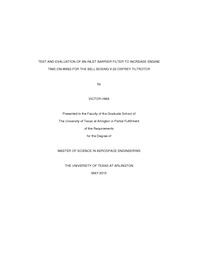
ATTENTION: The works hosted here are being migrated to a new repository that will consolidate resources, improve discoverability, and better show UTA's research impact on the global community. We will update authors as the migration progresses. Please see MavMatrix for more information.
Show simple item record
| dc.contributor.author | Hwa, Victor | en_US |
| dc.date.accessioned | 2015-07-31T22:10:07Z | |
| dc.date.available | 2015-07-31T22:10:07Z | |
| dc.date.submitted | January 2015 | en_US |
| dc.identifier.other | DISS-13073 | en_US |
| dc.identifier.uri | http://hdl.handle.net/10106/25041 | |
| dc.description.abstract | The Bell Boeing V-22 Osprey Tiltrotor has seen significant deployment to austere environments where airborne sand and dust is generated due to aircraft operation on, or near, the ground. Current V-22 production aircraft are equipped with an engine air particle separator (EAPS) to remove larger particles of sand and dust, but finer particulates remain an issue for engine combustion air. A prototype engine inlet barrier filter (EIBF) has been developed as a more robust particle filtration solution. Inlet air filtration with the prototype EIBF is expected to quadruple engine time-on-wing by preventing nearly all fine particulates from entering the engine. The prototype EIBF was installed on the left side of an MV-22 aircraft and was flight tested at the Bell Xworx facility in Arlington, TX with an inlet rake installed at the compressor face of the left-hand-side engine (#1 engine) to measure inlet pressures and temperatures. The author used this data to quantify inlet pressure recovery and inlet flow distortion. Measured data were correlated with analytical results obtained from Computational Fluid Dynamics (CFD); however, this thesis will focus on the flight test aspect of the test and omit technical details regarding the comparison between flight test and CFD. The inlet distortion analysis showed that stable engine operation was achieved with the inlet barrier filter installed. Engine performance was quantified by using Power Assurance Check data generated by the V-22 Vibration, Structural Life, and Engine Diagnostic System (VSLED) on-board the aircraft, where the treated engine (inlet barrier filter installed) was compared to the baseline production inlet configuration. Austere (sand environment) flight tests were conducted at Albuquerque, NM and salt water environment tests were conducted at Pensacola, FL. The inlet barrier filter treatment resulted in a system that maintained engine performance significantly longer than the baseline air particle separator.Distribution Statement A – Approved for Public Release; distribution is unlimited, as submitted under NAVAIR Public Release Authorization 2015-262 & 2015-364. | en_US |
| dc.description.sponsorship | Wilson, Donald R. | en_US |
| dc.language.iso | en | en_US |
| dc.publisher | Aerospace Engineering | en_US |
| dc.title | Test And Evaluation Of An Inlet Barrier Filter To Increase Engine Time-on-wing For The Bell Boeing V-22 Osprey Tiltrotor | en_US |
| dc.type | M.S. | en_US |
| dc.contributor.committeeChair | Wilson, Donald R. | en_US |
| dc.degree.department | Aerospace Engineering | en_US |
| dc.degree.discipline | Aerospace Engineering | en_US |
| dc.degree.grantor | University of Texas at Arlington | en_US |
| dc.degree.level | masters | en_US |
| dc.degree.name | M.S. | en_US |
Files in this item
- Name:
- Hwa_uta_2502M_13073.pdf
- Size:
- 3.945Mb
- Format:
- PDF
This item appears in the following Collection(s)
Show simple item record


